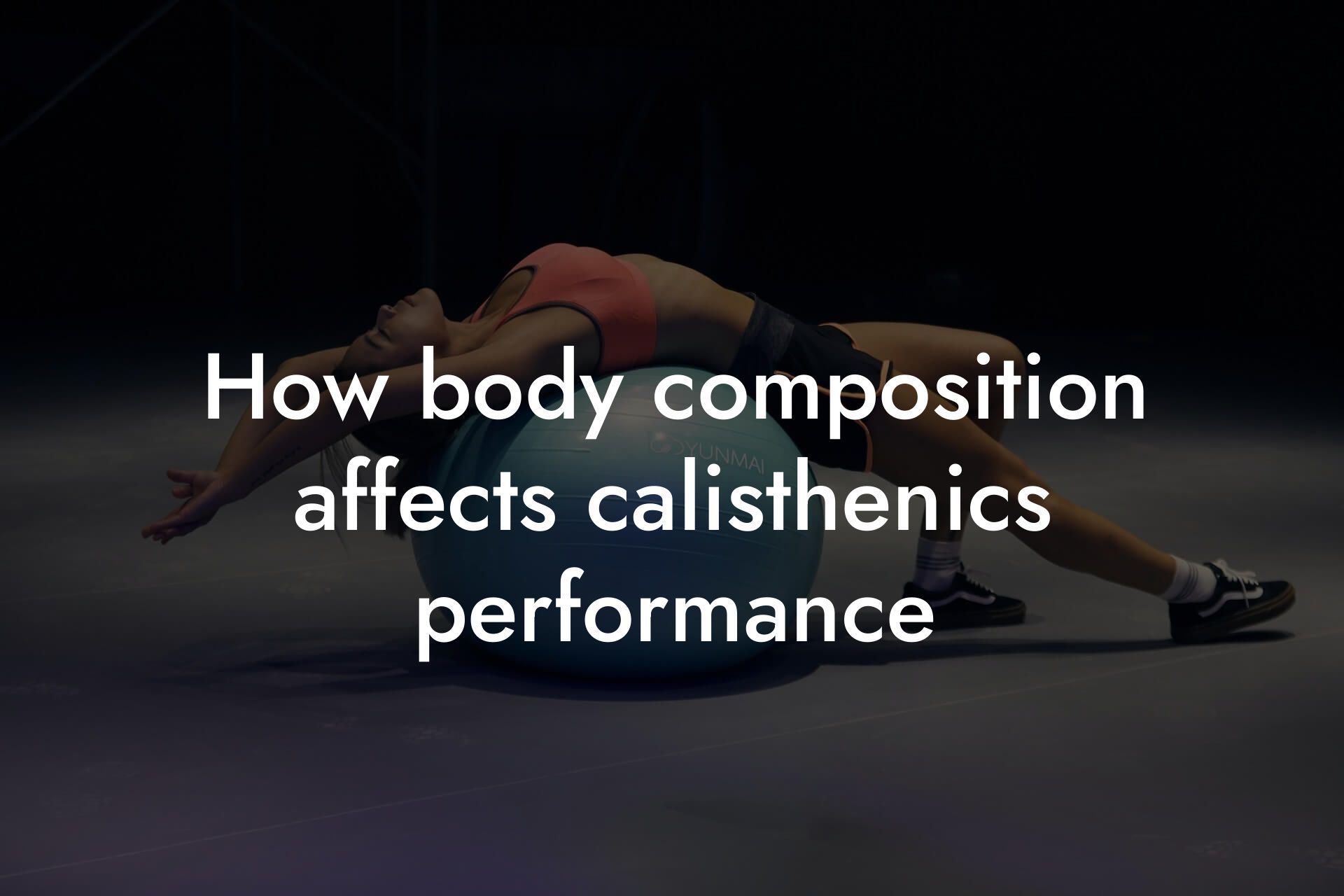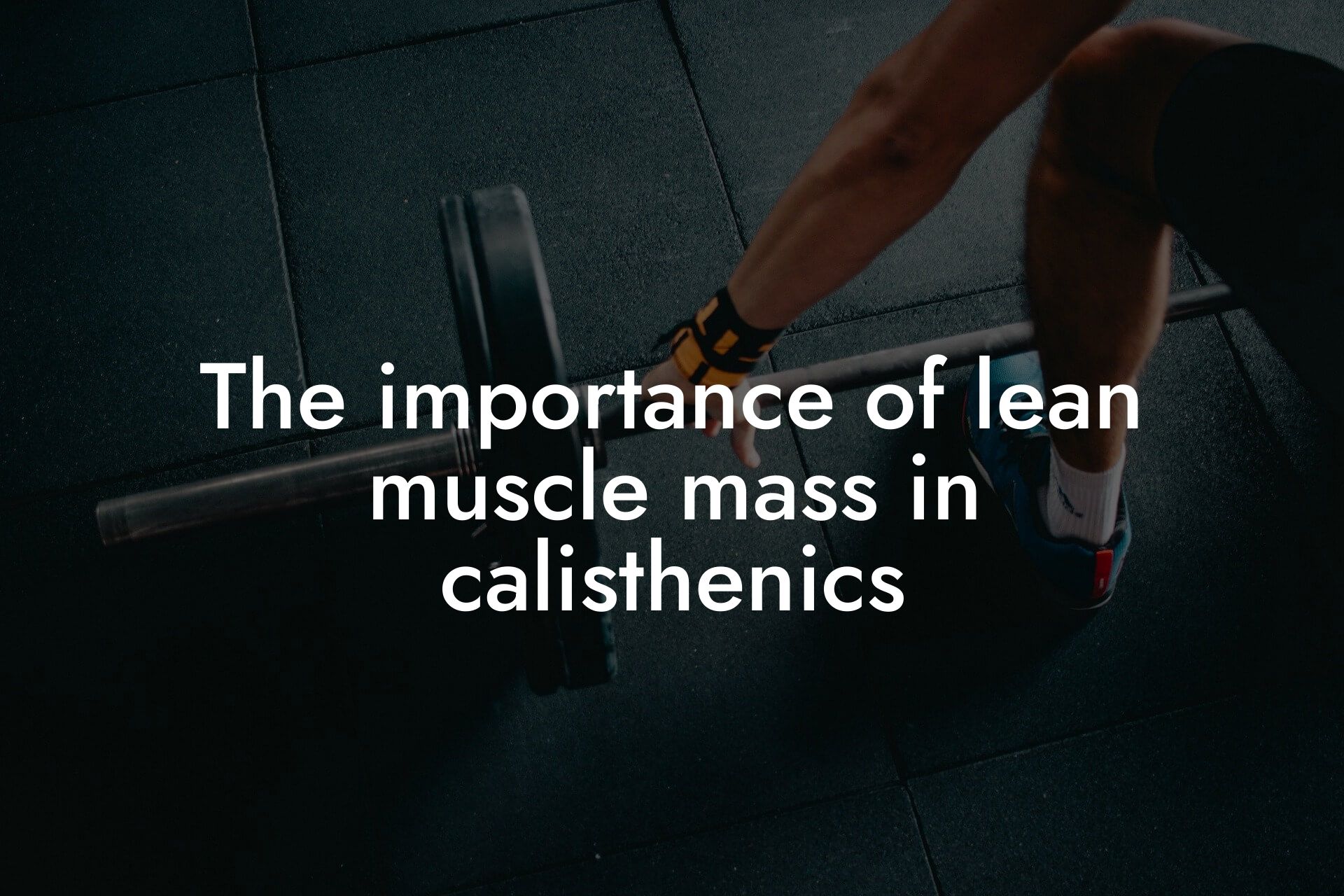As a calisthenics athlete, you know that pushing your body to its limits is a regular part of your training. However, it's equally important to prioritize recovery to avoid injury, prevent burnout, and optimize performance. In this article, we'll delve into the importance of recovery for calisthenics athletes and provide you with a comprehensive guide to recovery strategies that you can incorporate into your training routine.
Table of Contents
Why Recovery is Crucial for Calisthenics Athletes
Calisthenics training involves high-intensity movements that can cause micro-tears in your muscles, tendons, and ligaments. If you don't allow your body sufficient time to recover, these micro-tears can lead to injuries, chronic fatigue, and decreased performance. Recovery is not just about resting; it's an active process that helps your body repair, rebuild, and adapt to the demands of your training.
Recovery is especially important for calisthenics athletes because of the high-impact nature of the exercises. Jumping, landing, and explosive movements can cause significant stress on your joints, muscles, and bones. Without proper recovery, you may experience joint pain, muscle soreness, and decreased mobility, which can hinder your progress and increase your risk of injury.
Understanding the Different Phases of Recovery
Recovery is not a one-size-fits-all approach. There are different phases of recovery, each with its own unique goals and strategies. Understanding these phases can help you tailor your recovery plan to your specific needs and optimize your results.
The three main phases of recovery are:
1. Acute Recovery: This phase occurs immediately after exercise and lasts for 1-2 hours. The goal of acute recovery is to restore energy stores, reduce muscle soreness, and promote blood flow.
2. Sub-Acute Recovery: This phase lasts for 2-48 hours after exercise and focuses on repairing and rebuilding damaged tissues, reducing inflammation, and promoting adaptation.
3. Chronic Recovery: This phase occurs over a longer period, often weeks or months, and aims to maintain and improve overall fitness, reduce the risk of injury, and enhance performance.
Recovery Strategies for Calisthenics Athletes
Now that you understand the importance of recovery and the different phases involved, let's dive into some effective recovery strategies for calisthenics athletes:
1. Foam Rolling and Self-Myofascial Release: Foam rolling can help reduce muscle soreness, improve circulation, and promote relaxation. Focus on rolling your major muscle groups, such as your legs, glutes, and back.
2. Stretching and Mobility Exercises: Incorporate static stretches and mobility exercises into your routine to improve flexibility, reduce muscle tension, and enhance range of motion.
3. Contrast Showers: Alternate between hot and cold water in the shower to promote blood flow, reduce inflammation, and enhance recovery.
4. Compression Garments and Sleeves: Wear compression clothing to improve circulation, reduce muscle soreness, and enhance recovery.
5. Active Recovery Techniques: Engage in low-intensity activities like yoga, cycling, or swimming to promote blood flow, reduce muscle soreness, and enhance recovery.
6. Nutrition and Supplementation: Focus on consuming a balanced diet rich in protein, complex carbohydrates, and healthy fats. Consider adding supplements like protein powder, creatine, and omega-3 fatty acids to support recovery.
7. Sleep and Relaxation Techniques: Prioritize sleep, aiming for 7-9 hours per night, and practice relaxation techniques like meditation, deep breathing, or visualization to reduce stress and promote recovery.
8. Massage Therapy and Soft Tissue Work: Regular massage therapy can help reduce muscle tension, improve circulation, and enhance recovery.
Creating a Personalized Recovery Plan
No two athletes are alike, and what works for one person may not work for another. To create a personalized recovery plan, consider the following factors:
1. Training Intensity and Volume: Adjust your recovery plan based on the intensity and volume of your training.
2. Individual Needs and Goals: Tailor your recovery plan to your specific needs and goals, such as improving performance, reducing injury risk, or enhancing overall fitness.
3. Body Type and Composition: Consider your body type and composition when selecting recovery strategies, as some may be more effective for certain body types.
4. Lifestyle Factors: Take into account lifestyle factors like work, family, and social commitments when creating your recovery plan.
Monitoring Progress and Adjusting Your Recovery Plan
Regularly monitoring your progress and adjusting your recovery plan is crucial to optimizing your results. Use metrics like:
1. Heart Rate Variability (HRV): Monitor your HRV to track changes in your autonomic nervous system and adjust your recovery plan accordingly.
2. Subjective Feedback: Pay attention to how you feel, including your energy levels, muscle soreness, and overall well-being.
3. Performance Metrics: Track your performance metrics, such as strength, power, and endurance, to adjust your recovery plan and optimize your results.
Recovery is a critical component of any successful calisthenics training program. By understanding the importance of recovery, the different phases involved, and incorporating effective recovery strategies into your routine, you can optimize your performance, reduce the risk of injury, and achieve your fitness goals. Remember to create a personalized recovery plan, monitor your progress, and adjust your plan as needed to ensure you're performing at your best.
At Tano Performance Group, we understand the importance of recovery and offer comprehensive body assessments using our state-of-the-art DEXA machine. Our team of experts can help you create a personalized recovery plan tailored to your specific needs and goals. Contact us today to learn more and take your fitness to the next level.
Frequently Asked Questions
What is the importance of recovery in calisthenics training?
Recovery is a crucial aspect of calisthenics training, as it allows your body to repair and adapt to the physical demands of exercise. During intense calisthenics workouts, your muscles, tendons, and ligaments undergo micro-tears, which can lead to fatigue, soreness, and decreased performance. Adequate recovery strategies help to rebuild and strengthen these tissues, enabling you to train at a higher intensity and frequency.
How does inadequate recovery affect calisthenics performance?
Inadequate recovery can lead to decreased strength, power, and endurance, as well as increased risk of injury and burnout. When you don't allow your body sufficient time to recover, you may experience fatigue, soreness, and decreased motivation, ultimately hindering your progress and overall performance.
What are the common signs of inadequate recovery in calisthenics athletes?
Common signs of inadequate recovery in calisthenics athletes include persistent muscle soreness, fatigue, decreased strength and power, insomnia, mood disturbances, and decreased motivation. If you're experiencing any of these symptoms, it may be a sign that you need to reassess your recovery strategies.
What are the benefits of incorporating stretching into a calisthenics recovery routine?
Incorporating stretching into your recovery routine can help improve flexibility, reduce muscle tension, and enhance range of motion. Stretching can also help reduce muscle soreness and improve overall athletic performance.
How often should calisthenics athletes stretch?
Calisthenics athletes should aim to stretch at least 2-3 times per week, with a focus on major muscle groups such as the hamstrings, quadriceps, chest, back, and shoulders. It's also important to incorporate dynamic stretching into your warm-up routine before training.
What is the role of foam rolling in calisthenics recovery?
Foam rolling is a self-myofascial release technique that helps to reduce muscle tension, improve circulation, and promote recovery. By applying pressure to specific areas of the body, foam rolling can help break up adhesions and scar tissue, reducing muscle soreness and improving overall athletic performance.
How does compression clothing aid in calisthenics recovery?
Compression clothing can help improve blood flow and reduce muscle soreness by providing gentle compression to the affected area. This can be especially beneficial for calisthenics athletes who engage in high-intensity, high-impact exercises.
What is the importance of sleep in calisthenics recovery?
Sleep is a critical component of calisthenics recovery, as it allows your body to repair and adapt to the physical demands of exercise. During sleep, your body repairs and rebuilds damaged tissues, consolidates muscle memory, and regulates hormones, all of which are essential for optimal athletic performance.
How much sleep do calisthenics athletes need?
Calisthenics athletes should aim to get at least 7-9 hours of sleep per night to aid in recovery and support overall athletic performance.
What is the role of nutrition in calisthenics recovery?
Nutrition plays a critical role in calisthenics recovery, as it provides your body with the necessary building blocks to repair and adapt to the physical demands of exercise. A well-balanced diet that includes adequate protein, complex carbohydrates, and healthy fats can help support muscle growth and repair, as well as reduce muscle soreness and inflammation.
What are the best foods for calisthenics recovery?
The best foods for calisthenics recovery include lean protein sources such as chicken, fish, and eggs, complex carbohydrates such as brown rice, quinoa, and sweet potatoes, and healthy fats such as nuts, seeds, and avocados. It's also important to stay hydrated by drinking plenty of water throughout the day.
How does hydration affect calisthenics recovery?
Hydration is critical for calisthenics recovery, as it helps to regulate body temperature, transport nutrients and oxygen to the muscles, and remove waste products. Inadequate hydration can lead to decreased athletic performance, increased muscle soreness, and increased risk of injury.
What are the benefits of incorporating massage into a calisthenics recovery routine?
Incorporating massage into your recovery routine can help reduce muscle tension, improve circulation, and promote relaxation. Massage can also help reduce muscle soreness and improve overall athletic performance.
How often should calisthenics athletes get a massage?
Calisthenics athletes should aim to get a massage at least once a month, with a focus on areas of the body that are prone to tension and soreness, such as the shoulders, back, and legs.
What is the role of mental recovery in calisthenics training?
Mental recovery is a critical component of calisthenics training, as it allows you to recharge and refocus your mind. Mental recovery strategies such as meditation, visualization, and positive self-talk can help reduce stress and anxiety, improve mood, and enhance overall athletic performance.
How can calisthenics athletes incorporate mental recovery into their training?
Calisthenics athletes can incorporate mental recovery into their training by setting aside time each day to practice relaxation techniques such as meditation and deep breathing, engaging in activities that bring them joy and relaxation, and focusing on positive self-talk and visualization.
What are the benefits of incorporating active recovery into a calisthenics routine?
Incorporating active recovery into your calisthenics routine can help reduce muscle soreness, improve circulation, and promote relaxation. Active recovery techniques such as light cardio, yoga, and stretching can also help improve overall athletic performance and reduce the risk of injury.
What are some examples of active recovery techniques?
Examples of active recovery techniques include light cardio such as jogging or cycling, yoga, stretching, and low-intensity strength training. These techniques can help promote relaxation, reduce muscle soreness, and improve overall athletic performance.
How can calisthenics athletes incorporate active recovery into their routine?
Calisthenics athletes can incorporate active recovery into their routine by setting aside time each week to engage in low-intensity activities such as yoga or light cardio, incorporating stretching and foam rolling into their warm-up and cool-down routines, and engaging in activities that bring them joy and relaxation.
What is the importance of listening to your body in calisthenics recovery?
Listening to your body is critical in calisthenics recovery, as it allows you to identify areas of tension and soreness, and adjust your training and recovery strategies accordingly. By listening to your body, you can reduce the risk of injury, improve overall athletic performance, and optimize your recovery.
How can calisthenics athletes listen to their body?
Calisthenics athletes can listen to their body by paying attention to areas of tension and soreness, taking regular rest days, and adjusting their training and recovery strategies based on how they feel. It's also important to stay in tune with your emotions and mental state, and adjust your training and recovery strategies accordingly.
What are the benefits of incorporating technology into calisthenics recovery?
Incorporating technology into your recovery routine can help track progress, monitor recovery, and provide valuable insights into your training and recovery strategies. Technologies such as heart rate variability monitoring, GPS tracking, and recovery apps can help optimize your recovery and improve overall athletic performance.
What are some examples of recovery technology?
Examples of recovery technology include heart rate variability monitoring devices, GPS tracking devices, and recovery apps such as WHOOP and Oura. These technologies can help track progress, monitor recovery, and provide valuable insights into your training and recovery strategies.
How can calisthenics athletes incorporate technology into their recovery routine?
Calisthenics athletes can incorporate technology into their recovery routine by using devices such as heart rate variability monitors and GPS trackers, and apps such as WHOOP and Oura. These technologies can help track progress, monitor recovery, and provide valuable insights into your training and recovery strategies.
Here are some related articles you might love...
- Using DEXA scans to monitor progress in calisthenics
- How body composition affects calisthenics performance
- The importance of lean muscle mass in calisthenics
- Preventing injuries in calisthenics: A comprehensive guide
- Strength and conditioning programs for calisthenics practitioners
- Reducing body fat for improved strength-to-weight ratio in calisthenics
- Nutrition tips for calisthenics athletes
- Bone density and its role in calisthenics training
- How to build functional strength with calisthenics
Zak Faulkner
Zak Faulkner is a leading authority in the realm of physical health and body composition analysis, with over 15 years of experience helping professionals optimise their fitness and well-being. As one the experts behind Tano Performance Group, Zak has dedicated his career to providing in-depth, science-backed insights that empower clients to elevate their physical performance and overall health.
With extensive knowledge of DEXA technology, Zak specializes in delivering comprehensive body assessments that offer precise data on body fat, muscle mass, bone density, and overall physique. His expertise enables individuals to make informed decisions and achieve their fitness goals with accuracy and confidence. Zak’s approach is rooted in a deep understanding of human physiology, combined with a passion for helping clients unlock their full potential through personalised strategies.
Over the years, Zak has earned a reputation for his commitment to excellence, precision, and client-focused service. His guidance is trusted by top professionals who demand the best when it comes to their health. Whether advising on fitness programs, nutritional strategies, or long-term wellness plans, Zak Faulkner’s insights are a valuable resource for anyone serious about taking their health and fitness to the next level.
At Tano Performance Group, Zak continues to lead our Content Team revolutionising how professionals approach their physical health, offering unparalleled expertise that drives real results.




